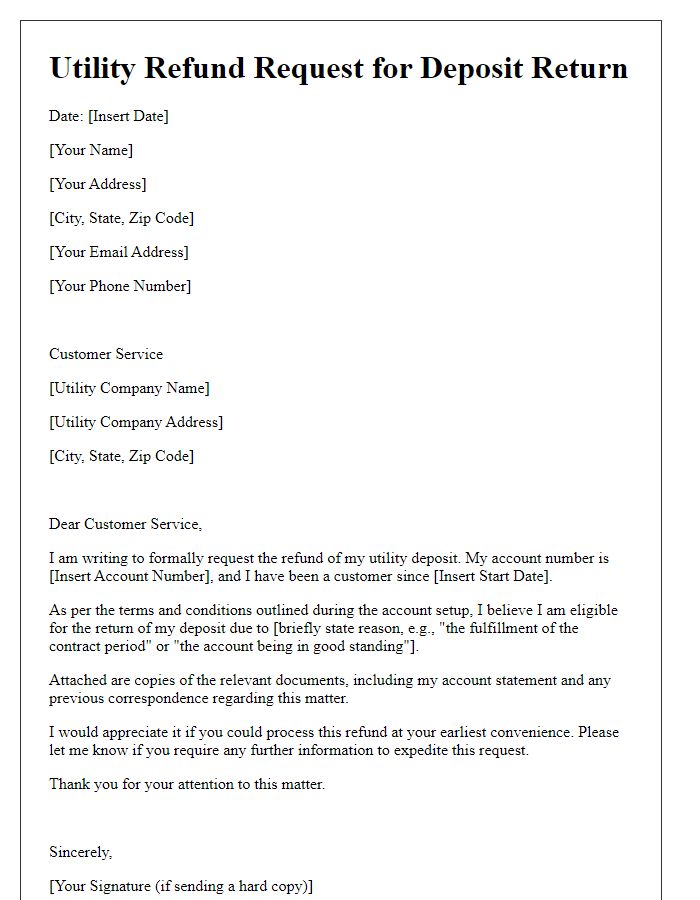Are you looking to reclaim some money from your utility provider? Writing a refund request letter can be straightforward, and it's your opportunity to explain why you believe a refund is warranted. In this article, we'll walk you through a simple letter template that you can use to effectively communicate with your utility company. So, let's dive in and get you on your way to securing that refund!

Clear Sender Information
Clear sender information includes essential details such as the sender's full name, mailing address, phone number, and email address. This information should be prominently displayed at the top of the request letter. For example, the sender's name could be John Doe, residing at 123 Main Street, Springfield, IL 62701, with a contact number of (555) 123-4567 and an email address of johndoe@email.com. Providing this information ensures the utility company can easily identify the customer and respond promptly to the refund request.
Precise Recipient Details
Utility refund requests require accurate recipient details for efficient processing. Include full name (John Smith), account number (123456789), service address (456 Maple Street, Springfield), contact information (email: john.smith@email.com, phone: 555-123-4567), and any relevant reference numbers (refund request ID: 98765). Ensure clarity in identifying the utility provider (Springfield Electric Company) and specify the refund amount ($150) being claimed. Also, mention the billing period (January to March 2023) to establish a clear timeline for the refund request. Accurate details expedite resolution, promoting customer satisfaction.
Subject Line and Purpose
Utility refund requests often arise from overbilling issues or service interruptions. A well-crafted subject line should be concise and specific, such as "Request for Refund Due to Overbilling on Account #123456." The purpose of the letter should clearly outline the reason for contacting the utility company, including details like the billing period in question (e.g., January 2023), the total amount disputed ($100), and any relevant service interruptions (e.g., power outage on February 15, 2023, lasting five hours). This precision helps ensure that the utility company can quickly locate the account and address the issue effectively, facilitating a smoother resolution process.
Explanation of Overpayment
Utility overpayments frequently occur due to discrepancies in billing cycles, estimated meter readings, or changes in service rates. For example, a residential customer in New York City may have noticed an overcharge on their water bill for October 2023 due to an incorrect estimate, resulting in a $150 surplus over the actual consumption, which was only $100. Moreover, utility companies like Con Edison or the New York City Department of Environmental Protection typically have protocols for refund requests, including the need for evidence of payment discrepancies, such as past bills and bank statements. Prompt addressing of overpayments ensures accurate financial records for households while fostering trust and transparency with utility providers.
Request for Refund Process and Timeline
Utility customers seeking a refund must follow specific procedures to ensure successful processing. Most utility companies, including major providers like Pacific Gas and Electric (PG&E) and Consolidated Edison, typically require customers to submit a written request, including account numbers, service addresses, and the reason for the request. Response timelines may vary; for instance, PG&E aims to process refunds within 30 days upon receiving documented requests, while others may take up to 60 days. It is crucial to retain copies of all correspondence and documentation related to the refund to facilitate tracking and resolution. Refund amounts will reflect overpayments, estimated refunds resulting from disputes, or credits from promotional offers. Understanding specific policies related to the applicable state regulations can further streamline the refund process.
Letter Template For Utility Refund Request Samples
Letter template of utility refund request after account dispute resolution.

Letter template of utility refund request for service interruption compensation.












Comments